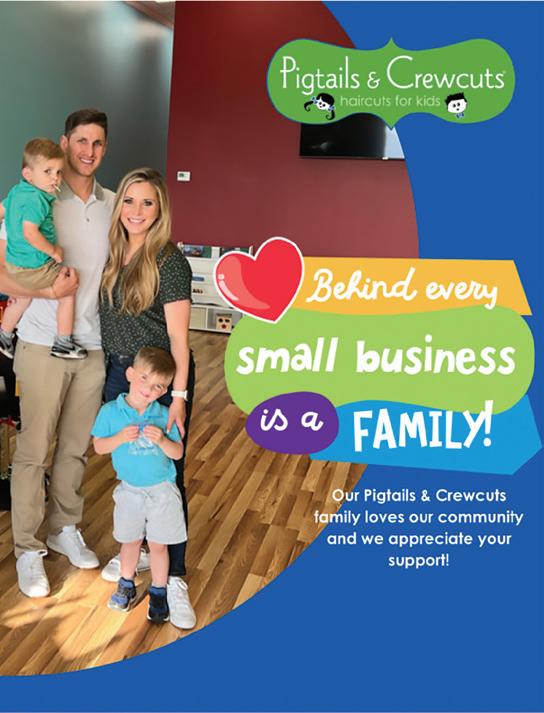
15 minute read
EMBRACING NEURODIVERSITY
IN THE CLASSROOM
BY ERIN PAGE. PHOTOS PROVIDED.
TRINITY SCHOOL AT EDGEMERE FOCUSES ON EDUCATING STUDENTS WITH LEARNING DIFFERENCES IN A SUPPORTIVE ENVIRONMENT.
PreK special education teacher Amber Wright-Eck has students who jump, spin or stand beside their desks during a lesson, students who are nonverbal and students with a variety of diagnoses that classify them as neurodiverse. Her goal with each of her students is to develop a trusting relationship and then determine how to help them reach their version of success.
Wright’s strategies along the way truly know no bounds. When one of her students had a disability that sometimes kept him from participating in activities because he couldn’t stand or walk for long periods of time, she built a special seat to accommodate him and keep him engaged. In addition to meeting her students’ individual needs, Wright facilitates regular conversations among her 3- to 5-year-old students about the value of differences and importance of inclusion. She encourages curiosity, questions and discussion. “If a child is spinning and another child thinks that looks strange, I might ask, ‘Have you ever tried spinning to see if it’s fun?’” said Wright, who teaches at Martin Luther King Jr. Elementary School in Oklahoma City Public Schools. “I let the kids ask questions and I’m honest about explanations. I welcome that in class. Let’s take the weird out of it. It’s neat how quickly the empathy and compassion come from kids if we allow it to happen.” Also of utmost importance to Wright is that typically-developing kids in her school have the opportunity to bond with her students with special needs, and vice versa. Those relationships beyond her classroom, both with students and general education teachers, are instrumental as she seeks to ensure as many of her students as possible are able to both transition to general education classrooms and be understood and celebrated for who they are. “One of our biggest goals is to be a more inclusive district,” said Erin Trussell, director of specially designed instruction for Oklahoma City Public Schools. “It comes down to exposure and training. We’re really pushing to get as many kids as possible into general ed and finding what supports we can give [neurodiverse students] in a regular classroom so they can participate as much as possible.”
What is neurodiversity?
Neurodiversity encompasses atypical ways in which brains can function, including learning difficulties like dyslexia and developmental diagnoses like autism spectrum disorder and ADHD. According to the Centers for Disease Control, one in six kids between ages 3 and 17 are considered neurodiverse. Leesa Lacey, MAMFT, LPC and CEO of Integrated Brain Health in Oklahoma City, says it’s imperative to teach all kids, starting at a young age, how their brains work and to emphasize that it’s OK to be different. “If every child is taught how they are wired, then we take away [the idea] that they are a bad kid or something is wrong with them … it takes away the stigma,” said Lacey.

Much like Wright does in her special education classroom, a study in Autism reported in 2020 that when classes and schools are taught facts about neurodiversity, students are significantly less likely to bully other kids for being different and are much more likely to be kind and inclusive toward those children. At Trinity School at Edgemere in Oklahoma City, more than half the student population has diagnoses of ADHD, generally in tandem with other diverse diagnoses, according to Traci Epperson, head of academic support and counseling. The school focuses on educating students with learning differences in a supportive environment, where conversations about accommodations and differences are common. “We need to be having more of these conversations in the world,” said Epperson. “Everybody needs support somewhere. I think people get caught up in the assumption that kids do stuff because they are lazy or defiant. We have found that when you take the cognitive load off kids who are struggling by offering accommodations, modifying assignments when necessary or providing extra support, they do better.”
Teaching kids about their brains
When feasible, Wright encourages students in her class to help explain their accommodations to their peers, like how carrying a comfort item helps them feel safe or moving their body during a lesson helps them focus. This basic level of understanding helps her students normalize that all brains and bodies function differently, and that’s OK. Lacey and her multidisciplinary team work with a variety of clients, from elementary through high school, assessing brain health, providing diagnostic assessments through a matrix she developed and implementing evidence-based treatment plans. The team at Integrated Brain Health provides ABA treatment, counseling, occupational therapy and interventional services under one roof, eliminating the need for clients who need comprehensive services to shuffle to multiple providers, potentially without a wholistic treatment plan guiding all parties. Lacey also looks at the relationship between nutrition, screen time and behaviors and explains to families how these factors impact neurodivergent kids. Lacey has found when kids and their parents understand the “why” behind their behaviors, they’re more accepting of themselves and others. “Information is a game changer,” said Lacey. “Their brain may be over activated here and under activated here. Their behavior is sending a message about something. They need help to understand how their brain functions and to be able to work on the issues.” A previous client was getting in trouble at school for fighting, which he would instigate when other students made fun of his clumsiness. He tested for dyspraxia, a condition affecting physical coordination, and that diagnosis helped him move from feeling anxious and angry to understanding that his condition was caused by a difference in his brain. Whether a child has ADHD versus sensory processing disorder, they are good at math but struggle in English, they are shy versus outgoing or they have difficulty with memory or executive functioning, families gain understanding of diagnoses and behaviors as a function of that child’s unique brain structure and then get the specific accommodations or help needed to allow that child to excel. Once a child and his or her family understands their unique needs, the next hurdle is often working with the child’s school and teacher. That process also requires a new way of thinking, which can be challenging for all involved, says Lacey. “We expect in schools for all children to do the same exact thing all day, every day, expecting everyone to learn the same way, and that is unreasonable at best,” said Lacey. “Parents’ expectations are based on society’s model, and we have to change that. The model is wrong.”

Integrated Brain Health
The IBH Di erence!
At IBH, we start with the "why?"
Often behind behavioral and emotional issues are undiagnosed learning disabilities, developmental, and neurological conditions. Using evidence-based diagnostic and assessment tools, we gather meaningful information about all areas of development, we will help determine the "why" behind the behaviors.
We have highly trained multi-disciplinary intake and assessment clinicians that look across multiple areas of developmental, emotional, and neurological functioning to determine best treatment options. Call us at (405) 702-9032 or visit our website at IBHealth.co
We accept most major insurances!
Occupational Therapy Applied Behavior Analysis, ABA Individual and Family Therapy 3838 NW 36th St, STE 200, OKC 73112 @integratedbrainhealth
Classroom supports for neurodiverse kids
While visible physical disabilities are often more understood — like the fact that a child without use of their legs needs a wheelchair — neurodiverse thinkers aren’t always accommodated on the same level. If a child needs an accommodation to be successful, even if that looks like jumping or running during a lesson or carrying a specific toy or fidget throughout the day, Wright says teachers and students can adapt more easily than they might think. “We are a fully-inclusive classroom with lots of different supports, and those accommodations don’t shut down the classroom,” said Wright. “Yes, we need expectations, but if a child needs to carry a [toy] car down the hallway [as a comfort item], I don’t need to shut down class for that. And the kids learn [that child] carries a car when we walk, and they let it go.” With all teachers have on their plates, Trussell says they need to be provided additional training and clear expectations to help neurodiverse students, especially considering the majority of general education teachers have only had one course in special education. But, like so many of us, teachers often need to understand the “why” behind a child’s behavior and how the accommodations benefit the student.
“They may be afraid they will do something wrong — they know there are laws involved — [so they may think], ‘if I can’t do it right, I can’t do it at all,’” said Trussell. “They have a thousand things going on, [so they need to hear], ‘this is what this kid needs and this is why he needs it.’” Thanks in part to manageable class sizes and low student-to-teacher ratios, teachers at Trinity can meet students where they are and offer a variety of accommodations. “We offer a lot of flexibility in how students present materials back to us,” said Epperson. “One accommodation is to allow verbal response instead of written. We diversify and differentiate in the classroom.” When it comes to writing a paper, some students can research and write without much support while others have a hard time focusing their search for information and need help refining and narrowing their research. Other students need additional support in the form of printed articles provided for them to use in writing their paper while some need a scribe to help them research, identify main points and put those thoughts together into a meaningful paper. All these options, and anything in between, are available for students. Trinity helps students improve executive function by explicitly teaching the steps to planning for, researching and organizing materials to write those research papers. “Every time we do a research paper, we teach the steps to take,” said Epperson. “It takes at least three times for most people to retain that … for some kids it will take 10 times and a little hand-holding.” In math classes, tangibles and visual aids accompany curriculum presentation, as do formula lists and final product examples. “Chunking” assignments means teachers break down a larger assignment into steps and check in with students at multiple points across the process. Trinity also focuses on “hidden” or “invisible” curriculum. For example, when students are helping with a school event and need to make phone calls, they’re taught the proper way to answer the phone and make a call. When needed, they’re provided a script and someone to sit with them while they make the first few calls. Epperson says it’s these types of life and executive functioning skills that are important for all students to be taught — but for those who are neurodiverse, it may take more repetition or support. Students also receive social coaching if they have difficulty with a peer or need help relating to another student. Teachers work with students to understand why name calling or making a negative comment about how someone reads or presents to the class is hurtful. Teachers also regularly pause lessons to address inclusivity and converse with students about the range of accommodations or supports others might need. “We don’t have tremendous behavior problems,” said Epperson. “I credit that with kids feeling safe and understood.”
Finding the right accommodations for neurodiverse students
Whether in an environment like Trinity, designed for neurodiverse students, or a general education environment, Wright advises parents to find or create community with other parents and families of neurodiverse kids, both to dispel the sense of loneliness and to share ideas on coping strategies or accommodations. A support team working together for the child’s best interest, with consistent communication between parents, teachers and therapists, is key. Therapists or professionals like Lacey can often provide helpful recommendations to both parents and teachers in terms of needed accommodations, and all parties can share successful strategies to be replicated throughout the child’s environments. When a child who is neurodiverse has had an official evaluation or diagnosis by their school district or private practice, those processes are often accompanied by suggested accommodations for the classroom, advises Epperson. She also recommends the sites understood.org, where parents can find a list of suggested accommodations based on specific diagnoses, and wrightslaw.com, which offers trainings and online information about the process of an IEP, special education law and how to advocate for a child with special needs. The book Child Decoded: Unlocking Complex Issues in Your Child’s Learning, Behavior or Attention by Marijke Jones, Dr. Robin E. McEvoy and Kim Gangwish is another resource that shares the full picture of what a neurodiverse child experiences, including overlapping neurodiversities, and breaks down areas of struggle, rather than categorizing by diagnoses, to help parents understand how to address challenges. Both the book Smart but Scattered by Dr. Peg Dawson and Dr. Richard Guare and website smartbutscatteredkids. com provide information and strategies that can help improve executive functioning. “Continue to ask where to find support for your child,” said Epperson.
Epperson encourages parents to expose kids to people who are different than they are. Whether through watching movies, reading books or simply talking about learning differences, when children understand the reasons behind others’ behaviors, they’re more likely to be accepting. Wright adds not to shut kids down if they are curious or want to ask questions about someone who appears different than them. Instead of telling a child not to stare, encourage conversation with the parent or individual themselves if they are amenable or simply have a direct conversation with the curious child. More communication, not less, is vital. She gives the relatable example of what to do when witnessing a child having a meltdown in public. “Instead of saying ‘that parent isn’t doing a good job,’ say, ‘Look how upset they are. Maybe they can’t find the right words or the lights are too bright,’” said Wright. “Change the narrative — as adults, we have that power.” Trussell shares that her typically-developing son has benefited greatly from his friendships with students who have special needs. As a young child he often visited his mom’s special education PreK classroom, and that normalization and celebration of others’ differences from a young age has translated into his becoming a devoted volunteer with the Special Olympics. Epperson also advises parents normalize that everyone struggles with something. For example, she’s shared with her kids that she’s not very organized and doesn’t like when she forgets to do something, so she works on keeping her calendar updated. “Talking about your struggles in front of children helps them understand that when they encounter problems, they, too, can overcome them,” said Epperson.
A future focused on inclusion
Epperson feels hopeful that recognition, acceptance and understanding of divergent thinkers is growing. “It’s frustrating that they don’t always fit very well in ways society expects but there are great success stories, too,” said Epperson. “It’s surprising to me how well many of our students make things work when they find something they are really committed to.” Trinity recently partnered with MetroTech so students could take concurrent classes. Teachers weren’t sure how students would fare in this type of learning environment without the same IEP mandates required in secondary schools but were determined to give students the opportunity.
www.yukonok.gov
Where History & Family Fun Collide!

Visit the Wild West Pumpkin Patch
Mollie Spencer Farm Sat., October 15 | Yukon, OK | 9:30 am - 5 pm

“It’s been amazingly successful and students have thrived,” said Epperson. “When [students] have had support all the way along [at Trinity] their ability to adapt to a more typical environment carries over because they are sufficiently motivated and able to advocate for themselves. I think it’s good evidence that neurodiverse students are capable of things people may not expect, and in giving students’ supports [in school], that allows the kid to figure out ways to get those needs met later on. Our students are able to find success in a wide range of environments, from life skills training to university programs.” As OKCPS strives to be even more inclusive of neurodiverse students, Trussell bemoans that still today in public schools around the nation and world, students with special needs are kept isolated in selfcontained classrooms. “Then what happens when they graduate and go into a public setting?” asks Trussell. “We as educators need to get them ready for that by keeping them in classrooms where they are exposed to typically-developing peers and vice versa. We are moving in the right direction.” Thankfully, teachers like Wright are not only serving neurodivergent students directly but also are helping prepare general education students and teachers alike to make space for them both in school settings and in the community at large. “Everyone has limits, but children are capable of more than we often give them credit for,” said Epperson. “We have to help them find the place where they will excel.”








What do accommodations look like for neurodiverse students?
Each child is different and requires individualized accommodations based on their unique needs. Examples of common accommodations from understood.org include:
Presentation accommodations:
• Listening to audio recordings instead of reading text • Working with text in a larger print size • Hearing instructions spoken aloud • Getting a written list of instructions
Response accommodations:
• Giving responses in a form that’s easier for them (spoken versus written) • Dictating answers to a scribe • Using a calculator or table of math facts • Using a spellchecker
Setting and timing accommodations:
• Sitting where they learn best in the classroom • Taking a test in a small group setting • Using sensory tools • Having extra time to complete a task, project or test • Taking frequent breaks
BABY TODDLER AFTERSCHOOL ADULT Training Kind, Respectful & Succesful Kids
S PA N I S H
UNIQUE CREATIVE AND CLEVER SESSIONS FULL OF JOY, CREATIVITY, EXCITEMENT & ACTION
MONTESSORI PRACTICAL SPANISH MANNERS DIVERSITY INCLUSIVE 3500 S BLVD. D1. EDMOND, OK. 73013 WWW.LIT TLESPANISHBRIDGE.COM E-mail. info@littlespanishbridge.com

